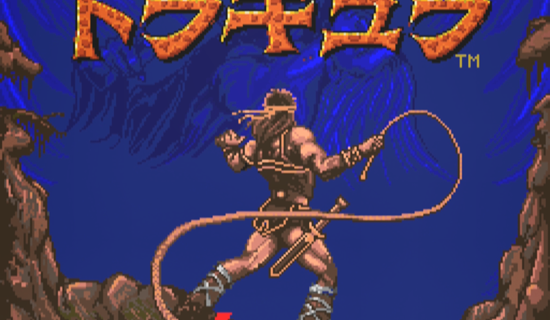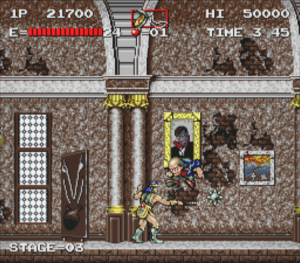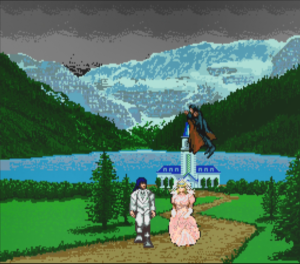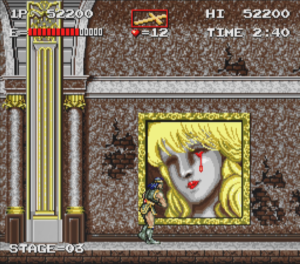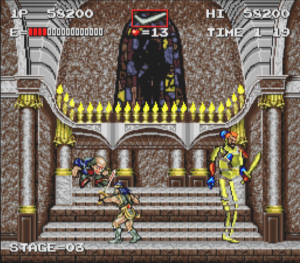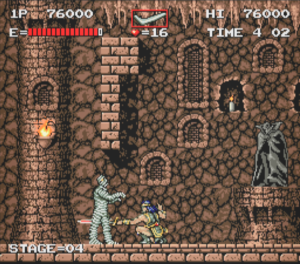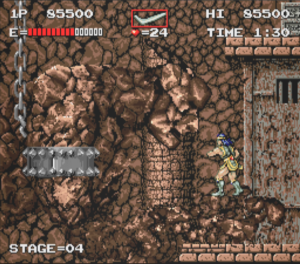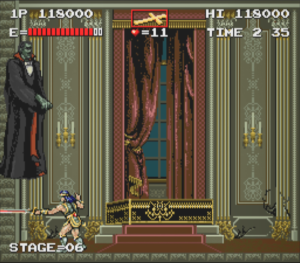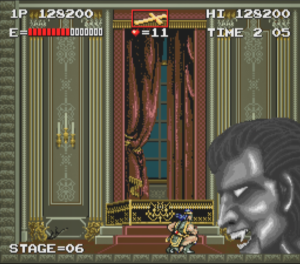The era in which a popular game franchise practically had to have an arcade installment was coming to a close in 1988, but it wasn’t over yet. It still was common for a game to establish itself as a hit in the arcade, and then have either a compromised or completely different game appear as the home console port. Castlevania/Akumajou Dracula was one of most notable exceptions that wasn’t developed by Nintendo, having already had two successful entries on the NES/Famicom Disk System. That was apparently the magic number to make someone at Konami think that it was about time for an arcade game.
Alright, fine…technically the first arcade Castlevania game was VS. Castlevania, which was released in American arcades in 1987. I’m not going to count that though, simply because it was just Konami test marketing NES games (there were other Konami VS. arcade games as well) in arcades before the home versions were released. It was the NES Castlevania game inside of an arcade cabinet, with some adjustments to make the game more difficult so that it could take as much of your money as possible.
And though this arcade game had the exact same name in Japan as the original game in the series (“Akumajou Dracula”, though it would be called “Haunted Castle” everywhere else), that wasn’t the first time this happened. “Akumajou Dracula” was also released on the MSX 2 computer on 10/30/1986, just one month after the original game released in Japan. And while aesthetics and feel remained more or less the same, the MSX 2 game was very different from its FDS predecessor. The Akumajou Dracula arcade game was clearly meant to do the same thing: It used the same illustration on the flyer that the FDS and MSX 2 games used for their own covers, with the tagline “伝説が再び血で染まる” (“The legend is once again stained with blood”). The flyer also specifically called out this game as having “magnificent graphics”, “fear-inducing sound effects and music”, and it being the “ultimate version of the game made popular on the MSX and Famicom”.
Despite these lofty claims, it didn’t end up in high distribution, even within arcades in Japan (more on why in a bit). It wasn’t in any way considered a hit, and was tough to find anywhere, even at the time. As a result, the board is now a fairly rare and expensive item. And so it became the first clear mistake in the Castlevania franchise. It’s easy to see why Konami would have thought this was practically a guaranteed arcade hit though. There was probably a lot of “As long as we follow the series formula, we’ll be fine!” kind of thinking going on. And if they’d done that a bit more completely, then we might very well think differently of Haunted Castle today. However this wasn’t a game made in a vacuum by people who didn’t understand at all what made Castlevania games great…they just missed maybe the most important part. But it does support 2-player alternating play! If for some reason you actually wanted to do that in a Castlevania game…
One of the claims on the arcade flyer is at least partially true: This is a good looking game. They really leaned into Simon’s initial Conan The Barbarian-like design for his sprite, and the Igors that appear in level 3 actually look like Igor instead of some strange red little creature. The sprites are also considerably larger than anything we’ve seen in the NES/FDS games. This isn’t a problem in of itself, but it may have contributed to one of the game’s major flaws. I prefer the smaller sprites from the earlier games myself though. They’re don’t pop as much and are lacking in detail, but they were extremely well designed for the age of the games and the hardware that they were on. Sprites that small probably wouldn’t have cut it for an arcade game in 1988 though.
I’m not sure if it’s “fear inducing” or not, but in carrying on the Castlevania tradition of having amazing music, this is Haunted Castle’s other high point. Kenichi Matsubara returns as composer, having previously done the music for Castlevania II. And if you can make it up to stage 3, he’s also brought a brand new version the song Bloody Tears with him! I’ve also seen composers Masahiro Ikariko and “T” credited for Haunted Castle as well, but as usual with multi-composer games of this vintage, it’s unclear who composed what.
The most amusing part of Haunted Castle is easily the story though, particularly the game’s opening cut-scene. I couldn’t tell you where this fits in the overall Castlevania lore (if it even does…has this game been stricken from the official records yet?), but Dracula has of course been resurrected from his 100 year sleep, and arrives just in time to kidnap Simon Belmont’s soon to be wife Selena right from their wedding ceremony! In order to save her, Simon now has to head toward Dracula’s castle. Seeing Simon in his white wedding tux as an increasingly more distorted version of Wedding March plays is very good.
In terms of controls, if you’ve played the previous Castlevania games you know what to expect. Jumping, crouching, whipping (which can also become spiked flailing or sword swinging, if you choose to pick up those weapons). Holding up and attack still allows you to use sub-weapons (torches, bombs, boomerangs, crosses, and timers). Hearts are also collected in order to increase the amount of times you can use your sub-weapons, and you can only have one sub-weapon at a a time. You’ll be attacked by slightly updated looking versions of all the enemies you’ve grown to know and love too: Skeletons, zombies, fish men, Igors, etc. Many of the bosses are even familiar faces, such as Medusa, Frankenstein’s monster, and of course Dracula (in probably one of the easiest iterations of his boss fight yet, though maybe not quite as easy as in Castlevania II). This is all very standard Castlevania fare so far.
Most of the patented Castlevania intricacies of movement are captured here as well. You still can’t change your jump arc in mid-air, and walking up and down stairs still requires you to hold the appropriate direction. The physical knock-back to Simon when he’s hit by an enemy is back too. They even made some sort of an attempt to recreate Simon’s chunky walk cycle, but he comes off as looking kind of hunched and constipated now. This is probably due to the larger and more detailed sprites being less forgiving for things like that.
As you can see, this is clearly not a game made by developers who didn’t know what Castlevania’s distinct qualities were, and what it was supposed to look and sound like. So where did they go wrong? Why does no one like this game? Well, they didn’t actually manage to make the controls FEEL like the other Castlevania games, even though they sound like they should be the same on paper. The first two games were never the most fluid action titles, but they had a very distinct rhythm to them that really worked once you found it. Haunted Castle is just slightly more slowed down and chunky feeling, which really manages to throw things off for those of us who are already familiar with the franchise.
And that patented Castlevania fiddly-ness is made far worse by the fact that, because this is an arcade game and designed to take money, they tend to throw a lot more enemies out at once than ever before. Even normal enemies take more hits than you would expect, at least until your weapon is more powered up (which doesn’t necessarily happen quickly). And maybe worst of all, Haunted Castle adopts the Gradius philosophy of dying: It sends you back to a checkpoint (if you make it to one), but you lose all of your power-ups. Yes, that’s what happened in all of the Castlevania games. But it feels so much more egregious here with everything that they throw at you and the time it takes to re-power-up.
On top of all that, the game is just generally buggy. Sometimes when an enemy drops a power-up when they’re killed in mid-air, the power-up just flies into the air and disappears! The accuracy needed to trigger the hit detection, particularly with small enemies like bats, also seems to be quite a bit more finicky than in previous Castlevania games. You can of course overcome all of this with practice, as is the Castlevania way. I just wish getting there felt as satisfying as it does with the NES titles.
The game also makes some weird level design decisions that don’t have much of a precedence in the series so far. The first level has a part where the scrolling stops and bricks fly off of a wall toward you. They have a pattern that isn’t particularly hard to figure out: You can just back off a bit, duck, and start whipping. But…why? It doesn’t really add anything and feels like it doesn’t belong in a Castlevania game. The second level have a part where boulders will just come rolling toward you out of nowhere, from off the side of the screen. You can’t really jump over them, you just have to time your movement to where you get through the area before they come falling. Again, not particularly difficult to figure out once you’ve taken hits from them a few times…but why? This really stinks of putting in something to wear down the player’s health unless they know exactly when it’s coming, because this is an arcade game.
With all I’d heard about how horrible of a game Haunted Castle was, I’ll admit it ended up being better than I expected it to be. I think everyone involved had their hearts in the right place, and they were absolutely trying to do right by the Castlevania franchise. There clearly was some love and care put into it, but it just didn’t end up going where it mattered most. I’m not sure if the eyes of any of the team members who worked on the original two games ever played this game to see how it felt before release, but it would be interesting to know if maybe that could have been the difference between what we got here and a game that would have been a more worthy entry in the series.
Not surprisingly, Hamster is the only company to have released home ports of Haunted Castle. The first was back in 2006 on the PlayStation 2, as a part of their “oretachi Geesen zoku” series of arcade ports (only released in Japan). That version included a soundtrack CD and DVD of game-play footage (like all of the other entries in that series). Much more recent and accessible though, is the 2016 release of Haunted Castle as a part of their popular Arcade Archives line of downloadable titles on the PlayStation 4.
